
‘Steve Buscemi doesn’t loom into view. He’s not a looming kind of guy. On an overcast day in June, as I waited on the designated corner of Union Square to meet him for the first time, I called his assistant. “He’s late,” I said. “Where is he?” Buscemi, it turned out, was standing thirty feet away from me. Round-shouldered and wafer-thin, in a gray work shirt, black chinos, and a weathered denim jacket, with a baseball cap pulled tightly over his forehead, he was virtually invisible in the crowd.
‘Five feet nine and forty-seven years old, Buscemi could be almost anybody-or everybody. Give him some tattoos and a mane of shaggy hair, and he’s the squirt-gun-toting heavy-metal doofus in Airheads (1994); put him in a blue sequinned dress, a red pageboy wig, and high heels, and he’s the world-weary transvestite taxi-dancer in Somebody to Love (1994); slick back his hair and give him a pair of brown loafers, like the ones he wore as Tony Blundetto in The Sopranos, and he has the gaunt, retro lounge-lizard look of the director John Waters. (In fact, the likeness is so uncanny that Waters used Buscemi’s image on his Christmas card one year.)
‘Nothing about Buscemi’s physical presence suggests the poetic lineaments of masculine film glamour. He is pale, almost pallid-as if he’d been reared in a mushroom cellar. In a certain light, he can look cadaverous. His eyes are large and bulgy, with a hint of melancholy. When he smiles, his mouth displays a shantytown of uneven, uncapped teeth. And yet that unprepossessing ordinariness is what makes Buscemi captivating as a performer. It gives him the unmistakable stamp of the authentic, and it helps to explain his emergence over the past two decades as an icon of independent films. (Buscemi himself understands the value of his rumpled looks. When his dentist suggested fixing his teeth, he told her, “You’re going to kill my livelihood if you do that.”) “Steve is the little guy,” says the director Jim Jarmusch, who cast Buscemi in his 1989 film Mystery Train. “In the characters he plays and in his own life, he’s representing that part of us all that’s not on top of the world.”
‘Buscemi’s persona is understated, opaque, bewildered, ironical. “You seem a little stoned. What are you on?” someone says to his character in Terry Zwigoff’s Ghost World (2000). He is in the hospital after having been betrayed, humiliated, and wrestled to the ground in a grocery store. “High on life,” he replies. “Steve’s a visitor in the world,” the director Alexandre Rockwell, who has worked with Buscemi on five films, said. “His body, his face-everything around him is whirling, but you always feel in Steve a stillness, almost a calm.” This stillness plays variously as anxiety, disconnection, and threat. Sometimes, a single character draws all three into a sort of trifecta of tension, like the silent hit man Mr. Shhh, in Things to Do in Denver When You’re Dead (1995). Buscemi’s look is deadbeat; his sense of humor is downbeat. He can play loss for laughs-in The Impostors (1998) he was Happy Franks, a suicidal cabaret singer sobbing his way through The Nearness of You — or he can play it for real.
‘All the characters whose stories Buscemi chooses to tell in his films share the same predicament: they are stuck in a purgatory from which they may or may not escape. The narratives compulsively return Buscemi to the unhappiness of his blue-collar youth; at the same time, they are a reminder of his triumph over it.’ — John Lahr
___
Stills
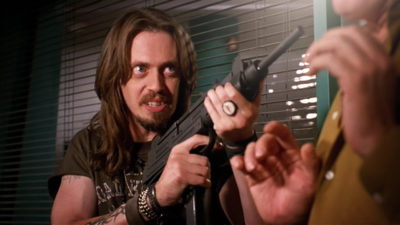
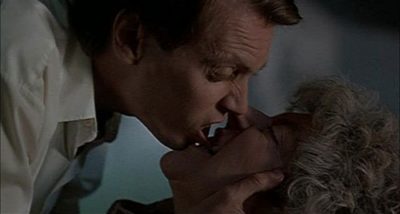
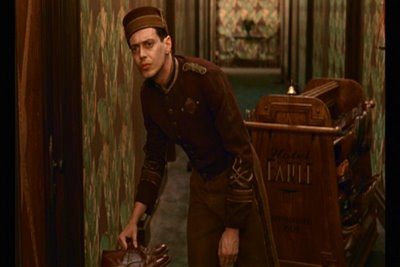
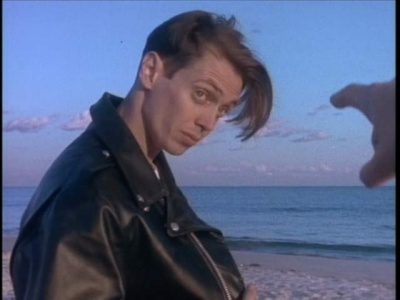

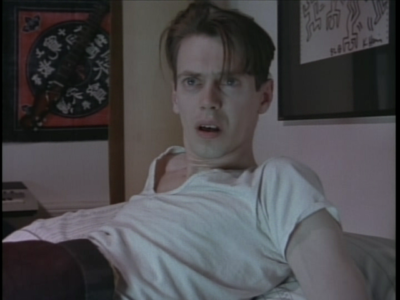

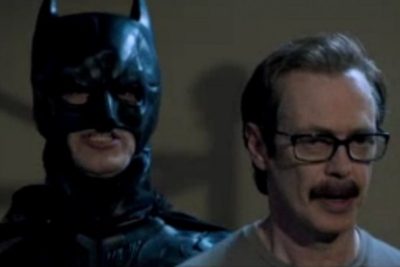
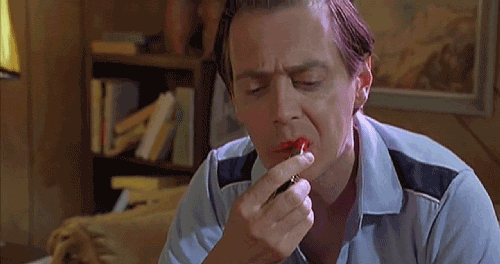
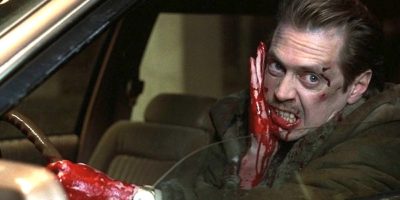


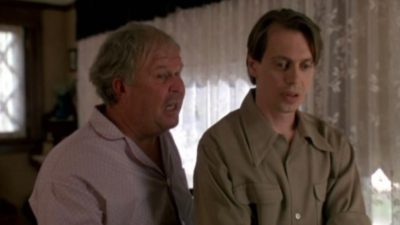
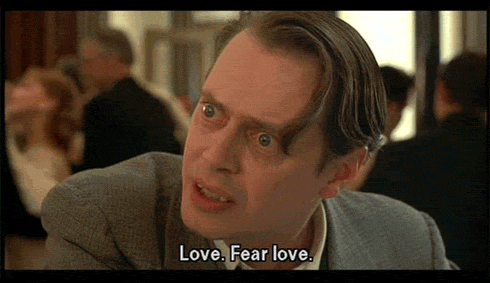
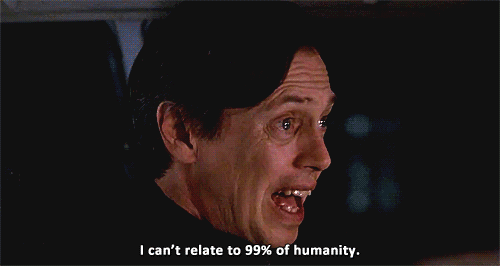










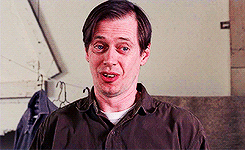
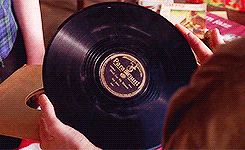

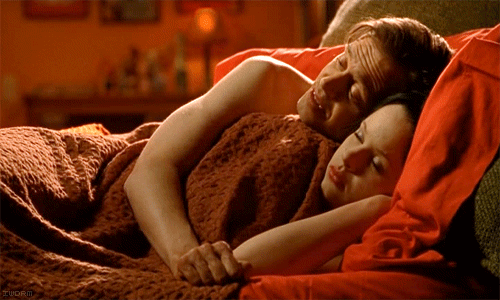
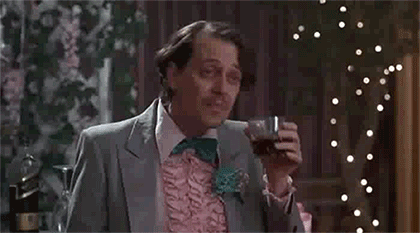
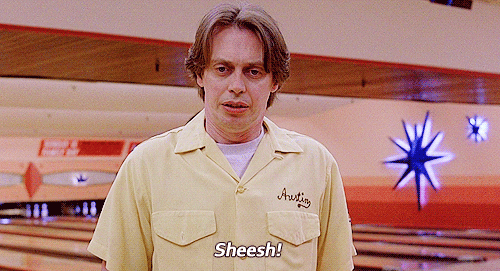

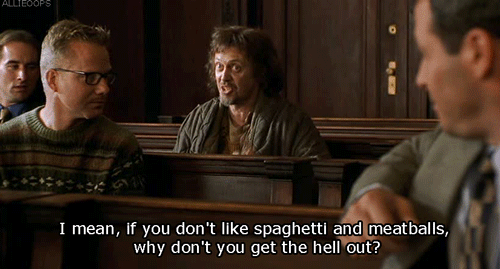
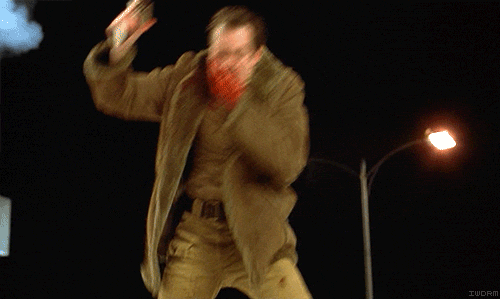

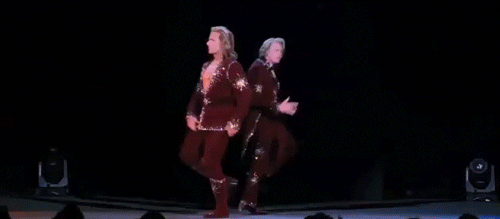

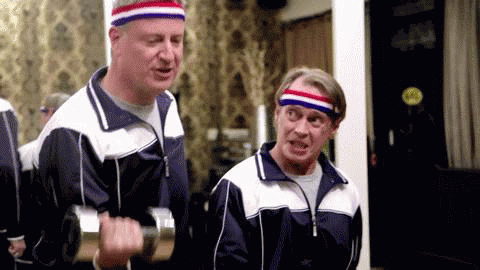
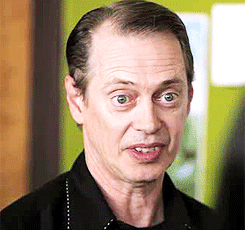

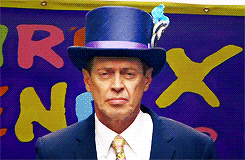
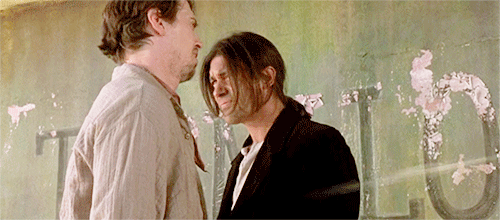
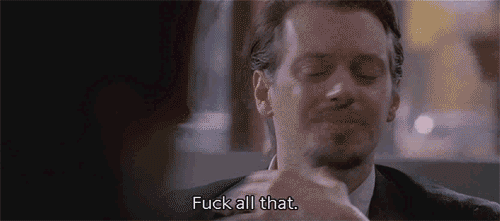
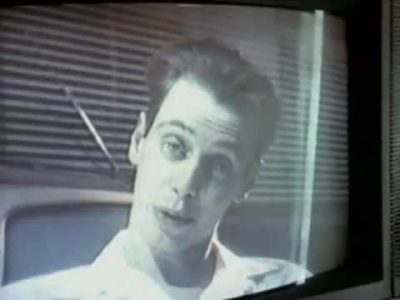

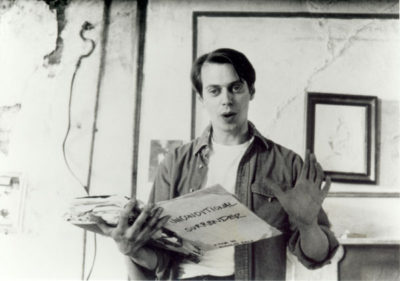
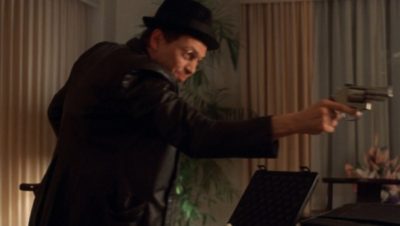
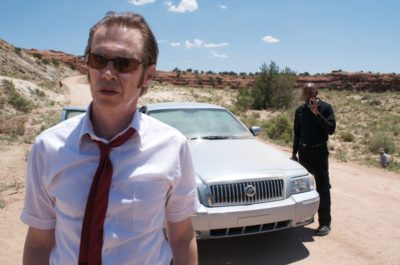
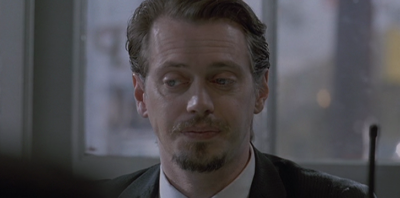

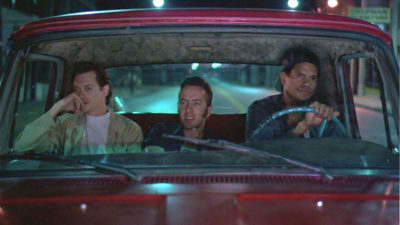
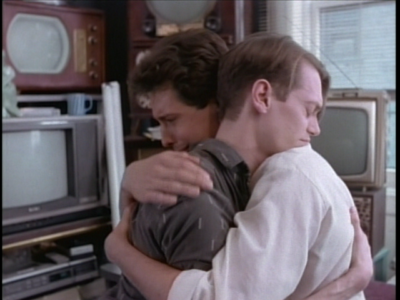
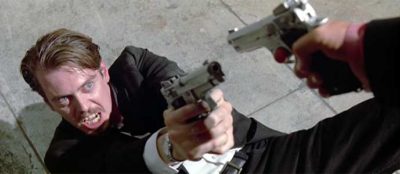
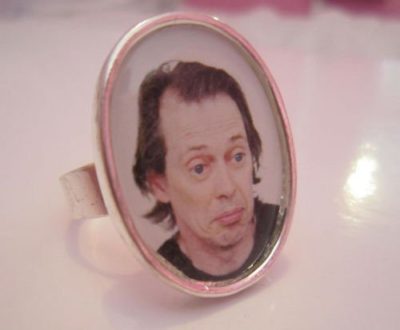


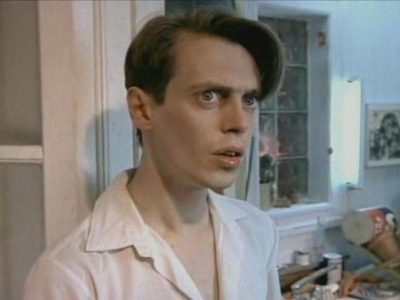
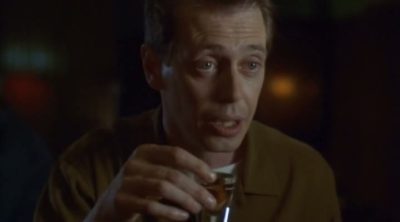

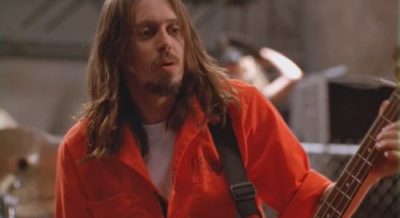
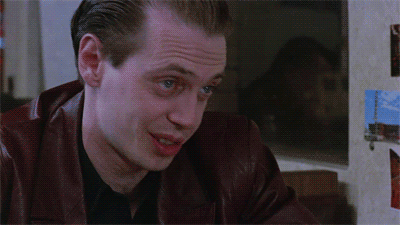

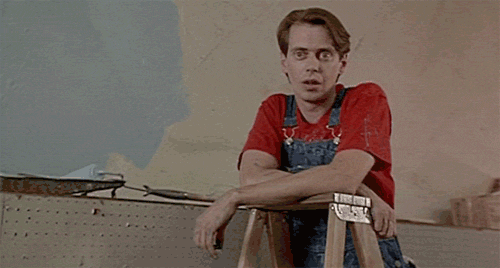
_____
Further
Steve Buscemi @ IMDb
Disney Princesses with Steve Buscemi’s Eyes
Video: Steve Buscemi Responds to the “Buscemi Eyes”
Steve Buscemi’s Top 10 @ The Criterion Collection
The Steve Buscemi Tribute Page
fuck yeah steve buscemi
’24 Times The Internet Professed Its Love For Steve Buscemi’>/a>
‘America’s Worst Tattoos: A Flat Steve Buscemi’
‘Steve Buscemi and Elvis Costello Went Trick or Treating’
‘Brief Encounters: Steve Buscemi’ @ Film Comment
‘Steve Buscemi no fan of city’s 25 mph speed limit’
‘Steve Buscemi Can Juggle’
‘Steve Buscemi Movies List: Best to Worst’
____
Extras
The Many Deaths of Steve Buscemi
Dinner with Vampire Weekend & Steve Buscemi
Henry Rollins – Steve Buscemi
Steve Buscemi’s sequence in ‘Paris Je T’aime’
Grimes Gives Steve Buscemi The Brush Off
_______________
Interviewed by Quentin Tarantino
from BOMB
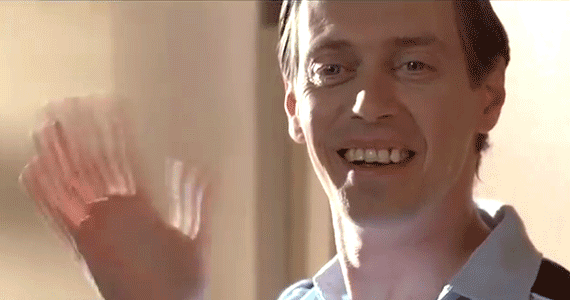
Quentin Tarantino Now, explain to the people how you came into acting. You were a fireman. When did you know you could quit firefighting and start acting full time?
Steve Buscemi It wasn’t until after Parting Glances came out and I was able to get an agent and then start to make a living.
QT You took a leave of absence and then decided not to go back? You put all your eggs in the same basket?
SB Yeah, my time was up and I had to go back, and the movie hadn’t been released yet, but I thought I just can’t go back. I really felt like Parting Glances was an important film. The character I played in that was probably the best character I will get to play. I just couldn’t imagine that this film wouldn’t get attention.
QT That happens in a lot of these independent films, especially if you have never heard of the people who are in them, they make the directors known, but the actors don’t get anything. No one’s ever seen those guys who were in She’s Gotta Have It again. No one’s ever seen anyone else in Parting Glances again.
SB That’s not true. Just because you haven’t seen them doesn’t mean they’re not getting work.
QT You’ve worked in low-budget independent films and big budget commercial films. In the Soup, cost $800,000 to make, but when you were actually shooting the budget was $300,000. And you had just come from doing Billy Bathgate, which was this $50 million production. What was the difference between the two?
SB In Billy Bathgate, Dustin liked to rehearse on camera, so we’d end up doing a lot of takes. Before we’d even do the take, we might discuss the scene for a long time. The crew would be waiting around outside and we wouldn’t even be rehearsing the scene, just talking about it. Not like I had a lot to contribute to these discussions: I was a fly on the wall. Dustin Hoffman, Robert Benton, Néstor Almendros, it was fascinating to be there. They really took their time. Of course, the sets were elaborate, the food was excellent, the dressing rooms were nice. But, I don’t know if all that stuff makes a better film. It makes it all more comfortable, it’s nice to have the time to do it. In In the Soup, we tried to get things done in two or three takes. We did all our rehearsals on our own before we got there. We had to work long hours, there was no going back. When you are shooting a film like In the Soup, it gives you this incredible energy, this excitement that comes from knowing that we have to get this now. Sometimes the pressure of that bothers me. But other times it inspires me, you can’t stop and think, you are just forced to do the scene and do it right. You are forced to go on instinct more. To me, it’s a valid way to work.
QT You have worked with a whole slew of directors, let me throw out some of their names and you give me little takes on them. Let’s start with the guy who more or less discovered you on film, the director of Parting Glances, Bill Sherwood.
SB Bill was a funny guy. He would give me very specific directions, almost line by line. And then say, “Steve, can’t you have a little spontaneity?” (laughter) Then we’d do another take and I’d be seething. It worked for that character. I don’t know if he was manipulating me intentionally, but it really did work.
QT Okay, Abel Ferrara’s King of New York.
SB I was the last guy cast for that. I remember calling the costumer to go over what I was going to wear. I said, “What do you have in mind for me?” and she said “Well, we had in mind that you were black.” I was like the token white. I would try on all these hats and Abel would come in and say, “Try on another hat, that’s not working.” We finally came up with something, but I don’t believe that he was ever really satisfied. As a consequence, I think he would position me in the back of the room.
QT Wasn’t there one shot in King Of New York that you didn’t know you were being filmed for?
SB Yeah, Christopher Walken’s character was just out of jail. I thought Abel had placed me on the side of the room so that I was out of the frame. I don’t even remember being in character. And then I saw the film and I was like, “Oh my God, I was seen that whole time?” (laughter)
QT How did he direct you and Larry Fishburne and choreograph the action?
SB He lets you feel it out for yourself. He says, “What’re you gonna do here? What’re you gonna do?” “Well, I thought I’d do this.” And he’d say, “Yeah, yeah, all right. Good, good. Do that, do that,” or, “Don’t do that. Do that other thing you were doing.” He’s always moving, he’s like a kid on the set. He gets excited. He says, “All right! This is gonna be great!” I mean when he first called me about doing the movie, I was on my way to LA to see what was happening out there. I had my ticket; I was leaving like the next day. He called me the night before and I hadn’t read the script. He described to me that first scene and that’s what made me want to do the movie. (laughter) It’s just the way he is. He’s just fun to be around, you know?
QT You’ve worked two movies with the Coen Brothers: Miller’s Crossing and Barton Fink.
SB I auditioned for Miller’s Crossing twice. The second time they said, “Well, you still say it the fastest.” And I was hired. (laughter) They’re really fun to work with. Joel always gave the first direction. But Ethan is right there and adds to it.
QT Does Ethan talk to you or does Ethan go through Joel?
SB He tells it to me with Joel there. The two of them are always together. I didn’t feel like I was getting conflicting information. They really complement each other. They get such a kick out of actors. In Barton Fink, I was doing this scene where I was picking up the shoes to put on the cart, you know, and then like I hear a noise and kind of stop, and then continue. They had me do that six or seven times because they enjoyed that scene: (laughter) “Well, we got it but let’s do it again.” And after that, “Let’s just do it one more time.”
QT Martin Scorcese.
SB I felt like I had already worked for him because on Last Temptation he brought me back four times. He had already cast that movie but there was a question of whether all the apostles were available. Each time he had me reading a different apostle. Then I did New York Stories. He gave me a lot of room. When people see New York Stories, they assume my character, a performance artist, is an asshole because of what Nick Nolte’s character says about him. But I didn’t play it that way at all, and neither did Scorcese. That whole monologue I did was something I wrote. I wouldn’t do my own material in a film if I thought it was going to be made fun of. It was funny, I never quite knew where Scorcese was on the set. I would hear him yell, “Action!” but I could never find him. He’d come over after each take and maybe say something and then disappear. Next thing I knew, “Action!”
QT Okay now, Jim Jarmusch.
SB He used to come see my partner Mark Boone Junior and I perform at these small performance spaces and clubs.
QT So you were already friendly with him?
SB Well, we weren’t really friends at that point. But he would come to the shows and we would hang out. Working with him on Mystery Train, I got to know him a lot better. He would make up scenes that weren’t in the movie for us to rehearse, to explore our characters. Stuff would happen in those improvisations that he would incorporate into the film. He trusts actors and casts people because he wants them to give more. He wants that input. Even on the set, we would do the takes as written and then sometimes have a take where he’d say, “All right. If there’s a line you want to change or something you want to add, do it.”
_________________
22 of Steve Buscemi’s 132 roles
__________________
Bill Sherwood Parting Glances (1986)
‘Parting Glances was the first movie about AIDS, made before Longtime Companion but around the same time as the television movie An Early Frost. But I never saw Parting Glances as an AIDS movie, just as a great character-driven New York film whose characters happened to be gay and living with AIDS. I didn’t see it as risky, because it was a wonderful part. I can’t see why anyone would turn it down just because the character, Nick, was gay. Nick is in a state of denial and shock about what he’s going through, and he doesn’t want to alter his lifestyle. It’s very important to him to keep working and not be treated as a sick person by his friends. At the same time, he feels his mortality and wants to re-establish that connection again with his former boyfriend, Michael, and let it be known that he loves him. This was an independent film and Bill had the creative freedom to do it as he wanted. Hollywood would have watered it down.’ — Steve Buscemi
Excerpt
Excerpt
Excerpt
______________
Jim Jarmusch Mystery Train (1989)
‘Like Jarmusch’s previous films, Mystery Train enjoyed a warm reception from critics. This was particularly evident at Cannes, where the film was nominated for the Palme d’Or and Jarmusch was commended for the festival’s Best Artistic Achievement. It was nominated in six categories at the 1989 Independent Spirit Awards: Best Picture, Best Screenplay (Jim Jarmusch), Best Director (Jim Jarmusch), Best Cinematography (Robby Müller), Best Actress (Youki Kudoh), and Best Supporting Actor (Steve Buscemi and Screamin’ Jay Hawkins).’ — collaged
Trailer
Excerpt
_______________
Abel Ferrara The King of New York (1990)
‘King Of New York was released during the most productive part of Abel Ferrara’s career so far. Arriving a year after 1989’s Cat Chaser – a filmmaking experience Kelly McGillis found so dreadful that she shaved her head and vowed never to act again – and the infamous Bad Lieutenant in 1992, King Of New York ranks among the best of Ferrara’s movies, and undoubtedly one of the most interesting gangster pictures yet made. King Of New York also arrived at a unique time in American filmmaking. It was among the earlier (but by no means first) movies to prominently feature a hip-hop soundtrack, and appeared in US cinemas a year before Boyz N The Hood and New Jack City – movies which dealt with similar themes such as crime and drug dealing to a much more lucrative effect. Aside from the obvious draw of Christopher Walken in the lead role, King Of New York is noteworthy for its extraordinary supporting cast, including Wesley Snipes, Laurence Fishburne, Steve Buscemi and David Caruso – all of whom were largely unknown before this film, but would later go on to forge hugely successful careers.’ — Den of Geek
Trailer
Excerpt
________________
Joel and Ethan Coen Barton Fink (1991)
‘Barton Fink won the Coen brothers the prestigious Palme d’Or when it debuted at the Cannes Film Festival in 1991. Starring John Turturro and John Goodman, with smaller roles filled by John Mahoney and Steve Buscemi, Barton Fink tells the strange tale of its titular character, a playwright who has just had his first major success on the New York stage, who reluctantly comes to Hollywood to write a script for a Wallace Beery wrestling picture. Stuck in a dank room in an ominous hotel, he meets Charlie Meadows (Goodman), an insurance salesman who seems to embody the working class everyman whose story Fink is so anxious to tell, if not to actually hear.’ — examiner.com
Trailer
______________
Alexandre Rockwell In the Soup (1992)
‘In the Soup is a charming pipsqueak of a movie, a playful film of ragged and shaggy appeal. All its virtues are small-scale except for one, because inside this little picture is the year’s largest, most robust pieces of acting, a performance that no one can resist, Aldolpho Rollo least of all. Aldolpho (Steve Buscemi) is Soup’s would-be hero. A timid, idealistic, embryo film director, he lives in a low-rent, walk-up tenement in Manhattan, a poster from revered Russian master Andrei Tarkovsky on his wall and dreams of glory in his heart. Someday he’ll make his movies, someday tour buses will visit his apartment and a plaque on the wall will commemorate his scuffling days. Someday maybe even Angelica (Jennifer Beals), the beautiful girl next door, will do more than snarl at him. But for now, with his erratic landlords, the Bafardis, on his case, what he really needs is money.’ — LA Times
Trailer
Excerpt
________________
Quentin Tarantino Reservoir Dogs (1992)
‘Tarantino’s original plan was to make Reservoir Dogs on a minimal budget on 16mm film, using friends in the cast, with himself playing Mr. Pink and regular producer Lawrence Bender as Nice Guy Eddie. Tarantino was introduced to the late Tony Scott in 1990 by a mutual friend, one of the director’s employees, and Scott read both True Romance and Reservoir Dogs. Originally, Scott wanted to make Reservoir Dogs, but was told by Tarantino that he’d earmarked it for his own full directorial debut. Scott ended up buying the True Romance script for $50,000, which Tarantino planned to use to make Reservoir Dogs. However, Bender’s acting teacher’s wife was a friend of Harvey Keitel, and gave him the script. Keitel became interested, and ended up attaching himself to produce and star as Mr. White, enabling Tarantino and Bender to raise as much as $1.5 million for the budget. As a result, the young writer-director was accepted into the Sundance Institute in 1991 (see photo), and travelled there with actors including Steve Buscemi to perform scenes from the script in front of advisers including Terry Gilliam and Two-Lane Blacktop helmer Monte Hellman. Gilliam is, as a result, thanked in the credits, while Hellman was so impressed that he attached himself as an executive-producer to the film.’ — Indiewire
Excerpt
Excerpt
________________
Jonathan Wacks Ed and His Dead Mother (1993)
‘There are some actors who don’t have to try very hard to convince you that whatever they say is the truth and the things they do are not out of character. Steve Buscemi is an example of an actor with this ability. Regardless of whether he is playing Carl Showalter, Seymour, or Mr. Pink, one never doubts that he is a petty thief, a record collector, or a career criminal. In Jonathan Wacks’s film Ed and His Dead Mother, Buscemi plays a mama’s boy and we totally buy it. Buscemi doesn’t always alter the timbre of his voice or even his body language unless the role demands a complete transformation. Yet, he slides into his characters and makes it look effortless. Though I might not picture Buscemi wearing overalls and a red t-shirt on my own, he dons this very outfit at the end of the film and he doesn’t appear uncomfortable or incorrectly robed. He isn’t the only actor who is at home in his role. Ned Beatty and John Glover perform nicely as two individuals trying to influence Ed to the best of their abilities. With a strong cast and a “timeless” set design—half 1950s, half 1990s— Ed and His Dead Mother is an eccentric gem.’ — Film Threat
the entire film
________________
Quentin Tarantino Pulp Fiction (1994)
‘Buddy Holly the Waiter is a character in Pulp Fiction, played by Steve Buscemi. It is a cameo in which he plays a waiter in Jack Rabbit Slim’s.’ — wiki.tarantino
Excerpt
________________
Michael Lehmann Airheads (1994)
‘A desperate rock band looking for a break, holds a radio station hostage in this youthful comedy. All the three Airheads Chazz, Rex, and Pip really want is a chance to play their quirky music. While they play club gigs, they have yet to drum up interest from any record companies. No one will listen to their demo tapes. After Chazz is tossed out by his girlfriend Kayla, he decides that desperate times require desperate measures and plans to break into station KPPX and play their demo on the air. The break in is successful, but they receive a cynical welcome. This drives Chazz to the edge and he pulls out a large semi-automatic and hijacks the station. The hostages are unaware that the band’s weapons are simply water pistols. They attempt to play their tape but it is destroyed by a temperamental machine. After the police and media arrive, the Airheads finally get their brief moment in the sun. A bit of a mess, but one of Steve Buscemi’s best performances before hitting the big time.’ — collaged
Trailer
Excerpt
________________
Tom DiCillo Living in Oblivion (1995)
‘I wrote Living In Oblivion in a state of mind teetering somewhere between homicide and suicide. After the dismissive release of Johnny Suede it was extremely difficult to get my next script, Box of Moonlight financed. And so one night, after getting plastered on martini’s at my wife’s cousin’s wedding, I stumbled into the Idea; a series of events taking place right on the set of a no-budget movie. All the things that could possibly go wrong actually do. The film is really a love/hate letter about the mechanics of filmmaking. I love this business but at times it really does feel that the entire process of making a film is designed to drive you into an insane asylum. Just when some miraculous moment is blossoming to life in front of you the camera screws up and that fragile, fleeting glimmer of beauty is gone. Of course the opposite is also true. But on a no-budget film the “unhappy accidents” can drop you to your knees.’ — Tom DeCillo
Trailer
Excerpt
________________
Robert Rodriguez Desperado (1995)
‘With this sequel to his prize-winning independent previous film, El Mariachi, director Robert Rodriquez joins the ranks of Sam Peckinpah and John Woo as a master of slick, glamorized ultra-violence. We pick up the story as a continuation of El Mariachi, where an itinerant musician, looking for work, gets mistaken for a hitman and thereby entangled in a web of love, corruption, and death. This time, he is out to avenge the murder of his lover and the maiming of his fretting hand, which occurred at the end of the earlier movie. However, the plot is recapitulated, and again, a case of mistaken identity leads to a very high body count, involvement with a beautiful woman who works for the local drug lord, and finally, the inevitable face-to-face confrontation and bloody showdown.’ — IMDb
Excerpt
__________________
Joel and Ethan Coen Fargo (1996)
‘Beautifully shot and wickedly funny, Ethan and Joel Coen’s warped homage to their home state earned nominations for everything from the Palme D’or to the Independent Spirit Award for Best Film (won) to Academy Awards (won two). The film is at times quiet as falling snow, observational; then suddenly bloody and hysterical all at once. With pitch perfect performances from Frances McDormand, William H. Macy, Steve Buscemi and a silent but deadly Peter Stormare, Fargo is everything you could ever want in a black comedy.’ — pajiba.com
Excerpt
Excerpt
Excerpt
_______________
Steve Buscemi Trees Lounge (1996)
‘An impressive feature debut from indie icon Buscemi, a serio-comedy and character study of a barfly (played by Buscemi) and the entourage that frequents the same working bar day after day; John Cassavetes would have been proud of this film.’ — collaged
Trailer
Excerpt
_________________
John Carpenter Escape from LA (1996)
‘Once again, our hero does the government’s bidding by dint of an implanted ”timer” (explosives in the original; a disease here). Plissken has to rescue the President’s daughter (A.J. Langer, from TV’s My So-Called Life) and retrieve a black box the feds need (like the audiotape in New York). Once in the city, he befriends a woman who is quickly, randomly killed (Season Hubley in New York, Valeria Golino in L.A.). There’s another tough guy (George Corraface), aided by another turncoat techno-weenie played by a hip actor (Harry Dean Stanton then, Steve Buscemi now). Zonked-out Peter Fonda has the Borgnine role, as a surfer dude who helps Snake out of a jam. If not for some jibes at political correctness and a wild cameo by Bruce Campbell (Ellen) as the surgeon general of Beverly Hills, the movie could just as easily take place in Schenectady.’ — EW
Excerpt
________________
Robert Altman Kansas City (1996)
‘When I worked with Robert Altman on Kansas City [in 1996], he said he didn’t care if the film made a nickel. If he wanted it to be successful, he wanted it to be successful on his terms. And then he immediately corrected himself and said, “On our terms.” To me, it meant that he cares about the films he makes and he cares about the people he makes them with. It was a philosophy he had that I think is really good.’ — Steve Buscemi
Trailer
Excerpt
_________________
Joel and Ethan Coen The Big Lebowski (1998)
‘Even I thought it was a weird follow-up to Fargo, and I didn’t expect anything from it. I just thought, “These guys made a really fun movie, a great character, kind of, genre, you know, weird genres that kind of mixed, and that it was really fun.” It’s probably the film that I’ve done that people have seen the most. I mean the number of times people have seen it. And I guess that started happening about five years ago, when people started to come up to me—usually it was like college guys that would tell me that they and their friends would watch it every weekend, or they had seen it five times. And at first, I didn’t really believe it, you know they say five times… or seven times. But so many people would tell me that now I believe it.’ — Steve Buscemi
Excerpt
Excerpt
______________
Michael Bay Armageddon (1998)
‘At one point during filming, Steve Buscemi mentioned to Bay that he was going to get dental work done. Bay convinced him that he had a “million dollar smile” and that he shouldn’t change a thing. Say what you will about Bay. That was a great decision.’ — Film School Rejects
Excerpt
Excerpt
________________
Terry Zwigoff Ghost World (2001)
‘I wanted to hug this movie. It takes such a risky journey and never steps wrong. It creates specific, original, believable, lovable characters, and meanders with them through their inconsolable days, never losing its sense of humor. The Buscemi role is one he’s been pointing toward during his entire career; it’s like the flip side of his alcoholic barfly in Trees Lounge, who also becomes entangled with a younger girl, not so fortunately.’ — Roger Ebert
Excerpt
Trailer
_______________
Pete Docter Monsters, Inc. (2001)
‘Monsters, Inc. is a 2001 American computer-animated comedy film directed by Pete Docter, produced by Pixar Animation Studios and released by Walt Disney Pictures. John Lasseter and Andrew Stanton were the executive producers. It was co-directed by Lee Unkrich and David Silverman, and stars the voices of John Goodman, Billy Crystal, Steve Buscemi, James Coburn and Jennifer Tilly.’ — IMDb
Monsters, Inc.’s Homage to Barton Fink
_________________
Jim Jarmusch Coffee and Cigarettes (2003)
‘Parents need to know that this movie is nothing more than people sitting around drinking coffee and smoking cigarettes and talking about various things. This film has no plot and no story structure. It’s a series of vignettes, short scenes that are like little slices of life. There is no violence or sexuality and some profanity, but the content of the film is based on conversation of rather mundane experiences.’ — Common Sense Media
Excerpt
_______________
Tim Burton Big Fish (2003)
‘After walking through a scary swamp, Edward discovers the hidden town of Spectre, where everyone is friendly to the point of comfortably walking around barefoot. Their shoes can be seen hanging from a wire near the entrance. When he enters the town he is greeted by the Mayor and his wife. The Mayor has a clipboard that says Edward was meant to be in their town but he had arrived early. He also tells him of the poet Norther Winslow (Steve Buscemi) who was also from Ashton. While there Edward has an encounter with a mermaid. She swims away before he could see her face. Edward leaves because he does not want to settle anywhere yet, but promises to the town mayor’s daughter Jenny (Hailey Anne Nelson), who developed a crush on him, that he will return. He believed that he was fated to be there someday.’ — collaged
Trailer
Excerpt
_________________
Steve Buscemi Interview (2007)
‘Steve Buscemi’s career is an American spin-off of the sea change in acting wrought by Alec Guinness 50 years ago. Buscemi’s sourpuss “full-on human rat mode,” as Variety put it recently, ratchets down mythic-sized characters to everyday guys working their humdrum psychopathic cons in plain sight. His characters are the alchemy of turning tragedy into dark comedy. Buscemi stars in two new films, both of which premiered at Sundance this past January: Interview, which he also directed, and, 11 years after starring in Living in Oblivion, Tom DiCillo’s Delirious. Both films are about media corruption, with Buscemi playing journalists at opposite ends of the food chain. In Interview, a remake of the Dutch film made by Theo Van Gogh, who was murdered in 2004 by a Muslim fanatic, he’s a serious journalist who’s been sent as punishment to interview a celebrity-fluff actress (Sienna Miller) and agonizes about being inside the room.’ — Film Comment
Trailer
Steve Buscemi on ‘Interview’
*
p.s. Hi. I’m in NYC. I’ll be having a conversation tonight at 7 pm at the Museum of Modern Art with my collaborator the choreographer Ishmael Houston-Jones and MoMA curator Thomas Lax if you’re there and want to come. If so, or if not, enjoy the restored Steve Buscemi Day.




 Now available in North America
Now available in North America 
Hi Dennis
Good luck tonight in NY and with the rest of your trip. Coincidence – I was thinking about this old post yesterday! Last night I watched two Buscemi films in a row specifically cos I felt like watching him – Ghostworld and Trees Lounge. Will probably continue the trend this evening. Working like a dog – my new PDF book GYMNASIUM is almost ready for release. Will happen this month for sure.
Best
Joe
Ever since he hit the ground running with “Parting Glances” Steve Buscemi has been an Axiom of The Cinema.
I especially love his appearance in “Paris Je T’Aime”
I’ve loved so many of Buscemi’s films over the years! Totally forgot he was in Escape from LA and Big Fish.
Hope New York is treating you well, Dennis and Zac!
Bill
Another reminder to watch Parting glances. I watched The Neon demon tonight.
I didn’t find it disappointing like some have. I haven’t seen anything like it, and I liked the fable quality.
I feel like leaving this video Dear tommy by
Chromatics
https://www.youtube.com/watch?v=nRTLABXixD0
Hi Dennis
Hope you’re enjoying NY. How was the day here? Glad the weather is just fine today.
I’d have loved to attend today’s event and bought a ticket too. But I’ve been a little too busy and exhausted now, so don’t think I can absorb anything even if I go there. I look horrible too, ha ha. So won’t be there. But hope to see you on 16th, if not for tea time. Can’t arrange anything for now, but hope you know I’m very very happy for your nyc events and new gif work. Enjoy your evening!
Have a great time in NYC and be safe, Big D!
hi dennis,
i saw you at moma tonight with ishmael houston-jones. it was really cool to see a facet of your work i was totally unfamiliar with. i thought it was a good discussion, you both seemed to be reticent about making these grand nostalgic statements about the 80s or playing the artist-activists, and to my generation (i’m 25) i think those kinds of things aren’t really giving us a sense of anything other than pedantry, it’s nice to hear from two people who were just trying to make work at the time and be creative rather than make a hammery statement. you said you were really interested in serial killers at the time of the knife/rope (i forgot the whole title?) performance. if you don’t know of her already (haven’t checked this blog in a while but you gave me some excellent recommendations for things to do in LA when i visited last spring, so, thanks for that) to recommend to you alissa bennett and her zines called DEAD IS BETTER. they are these excellent, hilarious second-person letters written to people like anna nicole smith or luka magnotta or cindy james (a nurse who kept claiming a person was stalking her for decades with no substantial evidence, only to be found dead herself in ambiguous circumstances years later). i think you would love them a lot, two issues are out and a third is forthcoming. i’ll try to make the new museum event and say hi, if not, i hope you have a good visit here. if you’re making time to see any art DREAMLANDS at the whitney is fantastic, esp. alex da corte/jaysson mason’s piece EASTERNSPORTS. alex da corte also has a show at maccarone gallery called A MAN FULL OF TROUBLE that’s definitely worth seeing, he has a really uncanny way of putting objects together that’s similar to mike kelley’s crazy talented sensitivities. x, john